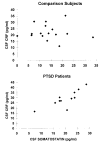Elevated CSF corticotropin-releasing factor concentrations in posttraumatic stress disorder
- PMID: 9137116
- PMCID: PMC3233756
- DOI: 10.1176/ajp.154.5.624
Elevated CSF corticotropin-releasing factor concentrations in posttraumatic stress disorder
Abstract
Objective: Corticotropin-releasing factor (CRF) and somatostatin both play important roles in mediating responses to acute and chronic stress. The purpose of this study was to measure CSF concentrations of CRF and somatostatin in patients with chronic combat-related post-traumatic stress disorder (PTSD) and comparison subjects.
Method: Lumbar punctures for collection of CSF were performed in Vietnam combat veterans with PTSD (N = 11) and comparison subjects (N = 17). CSF concentrations of CRF and somatostatin were compared between the two groups.
Results: CSF concentrations of CRF were higher in the PTSD patients than in the comparison subjects (mean = 29.0 pg/ml, SD = 7.8, versus mean = 21.9 pg/ml, SD = 6.0). This group difference remained significant after covariance for age. CSF somatostatin concentrations in PTSD patients were higher than those of the comparison subjects (mean = 19.9 pg/ml, SD = 5.4, versus mean = 13.7 pg/ml, SD = 8.0). However, covarying for age reduced the level of significance.
Conclusions: Higher CSF CRF concentrations in patients with PTSD may reflect alterations in stress-related neurotransmitter systems. The higher CSF CRF concentrations may play a role in disturbances of arousal in patients with PTSD.
Figures



References
-
- Delbende C, Delarue C, Lefebvre H, Bunel DT, Szafarczyk A, Mocaer E, Kamoun A, Jegou S, Vaudry H. Glucocorticoids, transmitters and stress. Br J Psychiatry. 1992;160:24–34. - PubMed
-
- Owens MJ, Nemeroff CB. Physiology and pharmacology of corticotropin-releasing factor. Pharmacol Rev. 1991:425–473. - PubMed
-
- Ottenweller JE, Natelson BH, Pitman DL, Drastal SD. Adrenocortical and behavioral responses to repeated stressors: toward an animal model of chronic stress and stress-related mental illness. Biol Psychiatry. 1989;26:829–841. - PubMed
-
- Dallman MF, Jones MT. Corticosteroid feedback control of ACTH secretion: effect of stress-induced corticosterone secretion on subsequent stress responses in the rat. Endocrinology. 1973;92:1367–1375. - PubMed
Publication types
MeSH terms
Substances
Grants and funding
LinkOut - more resources
Full Text Sources
Other Literature Sources
Medical

